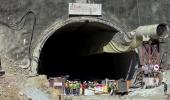'We humans may not have not created natural disasters, but we have definitely amplified their impact.'

"We need to appreciate the fact that nature comprises a variety of themes that are balanced by each other. If we reduce our intervention and unnecessary involvement, we can definitely make things better and prevent a number of problems," says Dr Naresh Rana, Assistant Professor of Geology at Delhi University.
Dr Rana's research interests include natural hazards, active tectonics and paleoclimate. He has more than 30 publications in international journals.
"We have to bear in mind the carrying capacity of the Himalayas and focus on alternative and sustainable techniques and projects," Dr Rana tells Rediff.com's Archana Masih in the concluding part of his interview discussing the factors behind the tunnel collapse in Uttarkashi and the lessons it has for us.
- Part 1 of the Interview: 'The Himalayas always surprise you'
How strong and safe are the other tunnels that have been constructed in the Lesser Himalayas in the past?
There are many tunnels that exist in the Himalayas. Wherever there are dams, there are tunnels.
Tunnels are considered safer as compared to roads because they do not encounter processes like landslides and debris flow.
They are safe structure if they are constructed adhering to the geotechnical configuration, providing the right treatment, taking care of the pressures and giving sufficient support system, etc.
The treatment technique of a tunnel is an extensive and expensive exercise.
There are very long tunnels in the Tehri dam and construction is going on for rail tunnels in Uttarakhand. If measures such as proper characterising of the rock mass; providing sufficient support and permanent lining are done as per criteria, tunnels can be very stable structures and will not collapse.

The workers were in the process of putting the permanent lining when a part of the tunnel collapsed. What is this process all about?
After excavation and boring of the tunnel, the rough walls have to be made smooth. Concrete structures or mini beams are used to anchor the rocks to prevent them from falling. If the rock is weak, you need to put more anchor in that area and finally you make a refined plastered tunnel.
The process of plastering, fixing permanent beams and structure inside the tunnel is called lining. The excavation is followed by building a temporary support system which is followed by the permanent lining. This is how tunnel works progresses.
What must be the condition inside the tunnel for the workers?
It is good that they can now communicate with the outside world and are getting food, medicines.
But the first few days must have been terrible for them. Fortunately, the portion where they are trapped is large enough for them to walk and move about.
The work has resumed and they will soon be out of the tunnel. It is this hope that has sustained them all this while.

What are some of the lessons that arise from this tragedy?
In the last decade there have been several accidents in the Himalayas like the two big floods in 2013 and 2021 and many floods in between.
There are different reasons for these incidents, for instance, the heavy rains that caused the Kedarnath floods or the collapse of the rock mass led to the 2021 Rishiganga floods. But there is a common thread running through these accidents which is the role of human beings.
We humans may not have not created these disasters, but we have definitely amplified their impact.
We repeat the same mistakes and follow the same pattern.
We cannot do anything about natural disasters, but we should introspect about our own role in amplifying it.
We need to appreciate the fact that nature comprises a variety of themes that are balanced by each other. Humanity has now acquired the power to disbalance this equilibrium between different parts of nature. If we reduce our intervention and unnecessary involvement, we can definitely make things better and prevent a number of problems.
We must remember that there is always some alternative, for example, building smaller and fewer dams instead of big ones.
Similarly, narrower, smaller, roads instead of wide, big roads. We have to bear in mind the carrying capacity of the Himalayas. We have to focus on alternative and sustainable techniques and projects.
We cannot go for short term development at the cost of our future.
Feature Presentation: Aslam Hunani/Rediff.com










